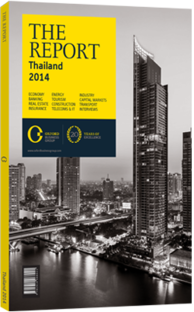New instruments: Expanding offerings and deepening the derivatives market
While derivatives trading has grown significantly since the launch of the Stock Exchange of Thailand’s (SET) Thailand Futures Exchange (TFEX) in 2004, liquidity remains concentrated. The SET’s development programme aims to introduce new hedging instruments, from non-agricultural commodity futures to currency swaps and a greater array of single stock futures (SSFs).
Innovation
By September 2013, TFEX’s product offering had expanded from one three-month futures contract on the SET50 Index introduced in 2006 to a range of derivative instruments. This included SET50 Index futures and options, 60 SSFs, sector index futures, BT50 ($1.64) and BT10 ($0.33) futures contracts on gold, five-year government bonds and six-month BT-FIX futures, interest-rate swaps, and futures for silver, Brent crude oil and the US dollar. The Agricultural Futures Exchange of Thailand (AFET) offers trading in agricultural commodities. Despite proposals to merge the two exchanges, this seemed unlikely as of early 2014 given their different regulators.
The sector futures launched in October 2012 cover the five most traded sector indices: banking, food, information and communications technology, commerce and energy. The exchange raised the number of SSFs on offer from three to 13 mid-cap stock futures in July 2013, including property developers (Asian Property), power producers (Ratchaburi Electricity), infrastructure (Bangkok Expressway) and agro-processors (Thai Vegetable Oil), but trading remains concentrated. “While there are 60 SSFs available on TFEX, the most traded are the banks and the property developers,” Sasikorn Charoensuwan, head of research at Phillip Securities (Thailand), told OBG. In 2012 the five most traded SSFs made up 78.76% of turnover. In January 2013 TFEX revised its position limits to allow investors to hold contracts on listed shares in the 20,000-435,000 contract range, rather than a single 20,000 contract level, permitting investors to more effectively manage portfolios. The reform raised SSF trading tenfold from 2012 levels to 80,183 contracts daily in January 2013.
Performance
The exchange has introduced other reforms to promote liquidity. The new trading system SET Connect launched in September 2012 for equity trading will expand to derivatives in 2014, while the Korea Exchange was contracted to launch a faster and more efficient clearing system in 2012. TFEX agreed with the Thailand Clearing House in May 2013 to lower trading and exchange fees for SET50 futures and BT50 ($1.64) gold futures from BT50 ($1.64) to BT35 ($1.14), and those on BT10 ($0.33) gold futures from BT10 ($0.33) to BT7 ($0.23). In November 2012 the exchange also established a derivatives investor protection fund to boost confidence by retail investors. The fund’s initial size is BT50m ($1.6m), although it is set to grow to BT100m ($3.3m) through broker contributions by 2016.
Volatility
By August 2013 local retail investors accounted for 55.46% of TFEX trading, local institutionals 35.3% and foreign investors 9.26%. The market is dominated by five of the 33 registered derivatives brokers in 2013, accounting for 38% of TFEX trades in the first eight months of 2013. Given the volatility of trading on TFEX, however, brokers have seen their margin requirements rise. “The futures market is volatile.
While the margin requirement used to be 5%, this has been raised to 8%,” Montree Sornpaisarn, Maybank Kim Eng Thailand’s CEO, told OBG.
Trading activity has grown exponentially in recent years, with a 35-fold increase in daily trading volumes to 43,823 contracts in 2012 and 78,650 in the first half of 2013, and a 20-fold increase in trading accounts to 80,393. The 79.5% year-on-year increase in daily trading in the first half of 2013 was driven primarily by SSFs, which accounted for 51.8% of daily trades. SET50 futures accounted for 31.3% of daily trades in this period, mini-gold futures for 11.5% and US dollar futures for 1.6%. The falling price of gold curbed enthusiasm for this asset class, although strong retail demand will likely drive a rebound in the medium term. “The volume of gold futures trading on TFEX fell by 40% since the gold price drop in April 2013,” Sasikorn told OBG.
You have reached the limit of premium articles you can view for free.
Choose from the options below to purchase print or digital editions of our Reports. You can also purchase a website subscription giving you unlimited access to all of our Reports online for 12 months.
If you have already purchased this Report or have a website subscription, please login to continue.

